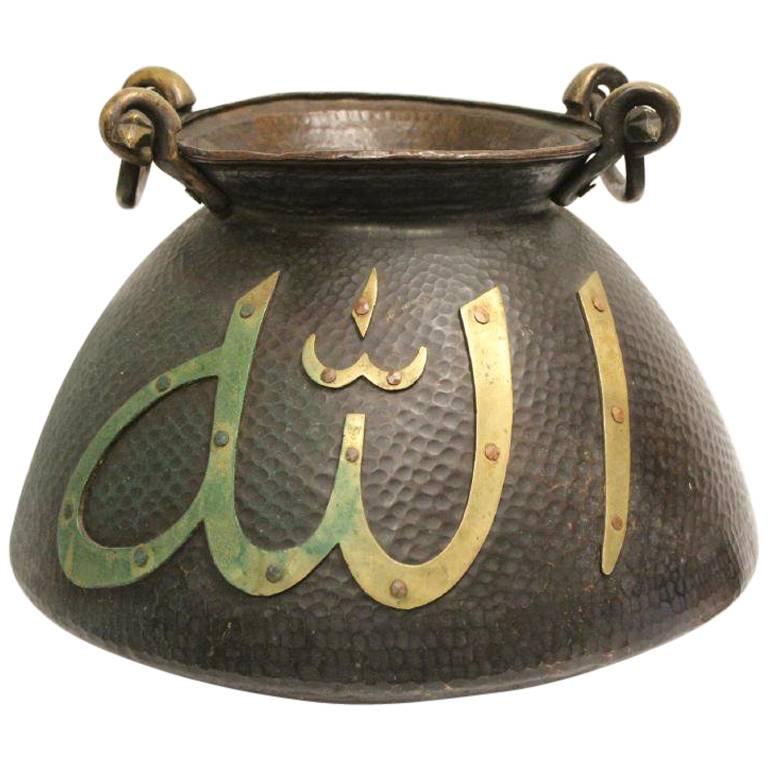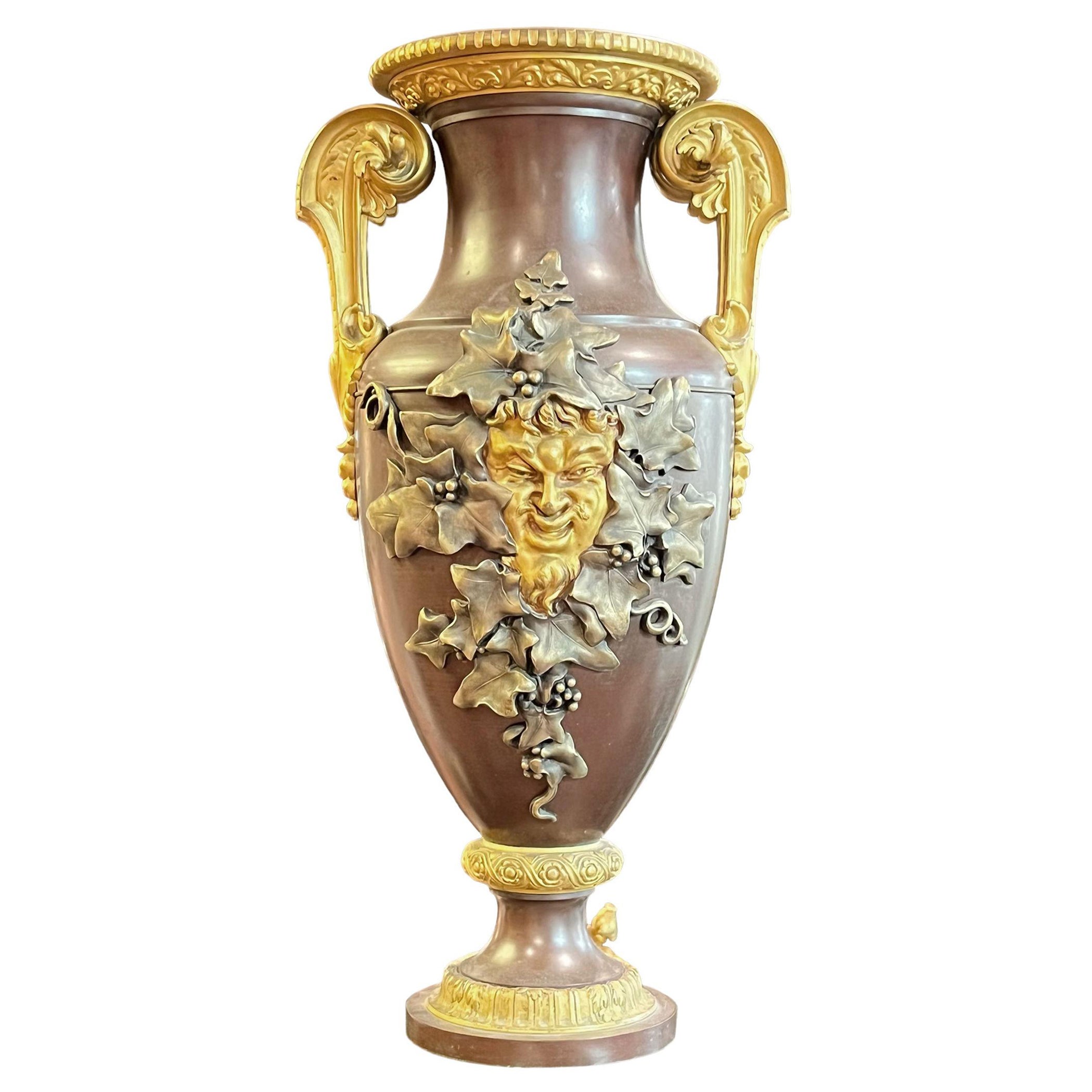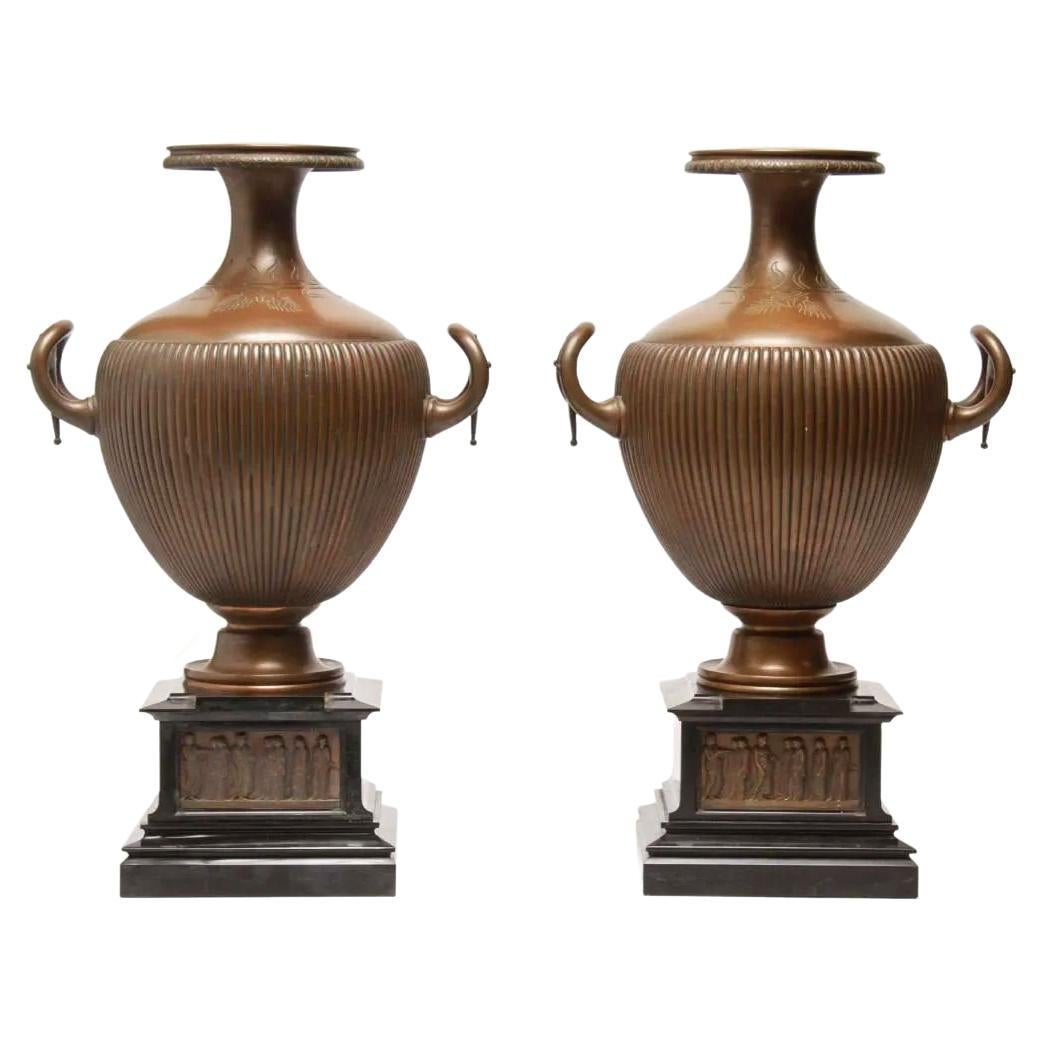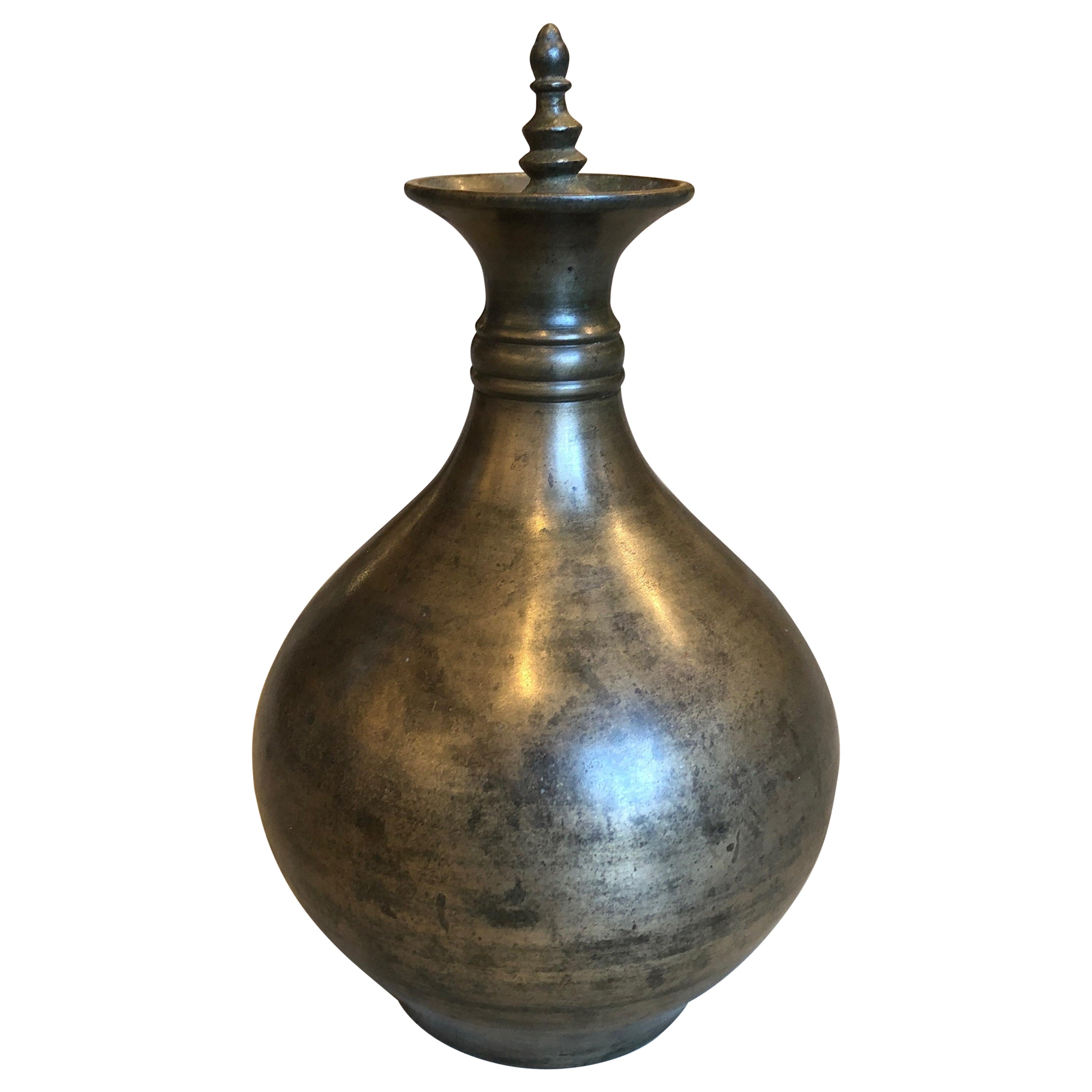Items Similar to Antique Patinated Bronze Hydria Water Jar After the Ancient Neopolitan
Want more images or videos?
Request additional images or videos from the seller
1 of 18
Antique Patinated Bronze Hydria Water Jar After the Ancient Neopolitan
About the Item
Our antique Grand Tour bronze hydria water jar after the original Greek design, circa 5th century BC, has a verdigris green patina and is finely cast with a winged laughing mask and hippocamps above and handles to the sides. Possibly from the Chiurazzi foundry of Naples.
- Dimensions:Height: 21.75 in (55.25 cm)Diameter: 12.75 in (32.39 cm)
- Style:Neoclassical Revival (Of the Period)
- Materials and Techniques:Bronze,Patinated
- Place of Origin:
- Period:
- Date of Manufacture:c1880s
- Condition:Wear consistent with age and use.
- Seller Location:New York, US
- Reference Number:1stDibs: LU6079238254122
About the Seller
No Reviews Yet
Vetted Seller
These experienced sellers undergo a comprehensive evaluation by our team of in-house experts.
Established in 1990
1stDibs seller since 2021
Typical response time: Several days
- ShippingRetrieving quote...Ships From: New York, US
- Return PolicyA return for this item may be initiated within 2 days of delivery.
More From This SellerView All
- French Ormolu and Patinated Bronze-Mounted Marble Vases with Covers by GagneauLocated in New York, USOur pair of vases with covers by Gagneau of Paris, originally fitted as oil lamps, are modelled as neoclassical maidens supporting vases. Crafted from rouge marble with ormolu bronze mounts. Removeable lids reveal the removeable pierced fittings stamped GAGNEAU. Gagneau a Paris, also known as Maison Gagneau...Category
Antique Late 19th Century Urns
MaterialsBronze
- Tragedy Bronze Figure After Francisque Joseph DuretLocated in New York, USOur patinated bronze, La Tragédie, after the French sculptor, Francisque Duret (1804-1865) measures 37.5 in (95 cm) and is in good condition, with a warm green-tinted brown patina. Originally sculpted in marble, La Tragédie and La Comédie were commissioned by the Théâtre Français in 1851. Residing in Salle Richelieu, part of the Palais-Royal complex in Paris, it is the oldest continually operating theater company in the world. Marbles of La Tragedie and La Comedie also reside in the collection of the Musée des Augustins in Toulouse, as seen in our photo. The artist was the son of the accomplished sculptor, François-Joseph Duret...Category
Antique 19th Century French Neoclassical Revival Figurative Sculptures
MaterialsBronze
- Pair Lenti Murano Glass Vases After Ercole BarovierBy Ercole BarovierLocated in New York, USOur beautiful rare pair of Lenti glass vases from Murano, after the innovative series by Ercole Barovier for Barovier, Toso & Co, 1940, are crafted from iridized pale violet glass wi...Category
Late 20th Century Italian Mid-Century Modern Vases
MaterialsArt Glass
- Monumental Antique Bohemian Gilt Glass VaseBy Harrach GlassworksLocated in New York, USOur very large (33 1/2 inch tall) and elegant gilt-decorated glass vase on stand dates from the third quarter of the 19th century. Attributed by ...Category
Antique Mid-19th Century Czech Neoclassical Vases
MaterialsGlass
- 19th Century French Empire Style Ormolu and Patinated Bronze Figural CandelabraLocated in New York, USOur pair of antique (19th century) French ormolu and patinated bronze three-light candelabra are of the highest quality, with neoclassical female figures holding candle arms in the...Category
Antique 19th Century French Empire Revival Candelabras
MaterialsBronze
- Boucheron Parcel Gilt Silver Vase and Oil Lamp circa 1880By Fréderic BoucheronLocated in New York, USOur important parcel-gilt and patinated silver and glass-mounted vase and matching oil lamp were designed by Paul Legrand (1840-1910) and crafted by the silversmith, Charles Glachant, for Boucheron of Paris, circa 1878-1880. 21 in tall and 16.5 in wide (53.4 by 41.9 cm). 28.56 lbs, 457 oz, 14,210 g. Provenance: presented to or purchased by Jean-Baptiste Pezon (1827-1897); acquired by a European private collector, perhaps on the death of Jean-Baptiste Pezon in 1897, by descent; acquired by YM Antiques, 2017. This double walled vase has an amphora form, with body and foot with silver, gilt and patinated and stylized flowers, anthemions and sprays of cherries against an etched and matted ground pierced to reveal a gilt inner wall. The upper body is detachable via a slip-lock, and mounted on both sides with arched panels formed of hexagonal beveled glass tiles. One glass panel applied with bacchic infants taunting a rearing goat and the other side with infants feeding grapes to a lioness under a looming bust of a satyr. The patinated and gilt upswung loop bifurcated handles are mounted with fully modeled figures of Pan bearing a syrinx and thyrsus and a draped maenad playing two flutes, both above roaring lion heads, the rim inset with a slip-lock detachable gilt bowl etched with masks of various representations of Bacchus spaced by ribbons and trophies and with scrolling fruiting vines. The base of interior with detachable base metal drip pan to accommodate the removable oil lamp designed to illuminate the glass tiles from within. The lamp is raised on four hoof feet, the upturned ends cast underneath with masks and with detachable cover mounted with two infant satyrs and flanked by gilt loop handles. The bacchic themed design featuring cartouches depicting infants taunting a goat and lion, plus prominent lion masks at the handles, certainly appealed to Boucheron's customer, Jean-Baptiste Pezon (1827-1897), who is believed to have commissioned the piece. Pezon was the celebrated lion tamer and headliner of the Grande Menagerie whose profession brought him great fame and fortune in Paris. Born a shepherd boy in Lozere, he is said to have left his home at the age of seventeen in the company of a wolf he had captured and trained years earlier. He headed to Paris and by the age of twenty-one purchased his first lion who he named Brutus. The animal is said to have inspired the Lion of Belfort, the monumental red standstone sculpture by Frederic Bartholdi erected in Belfort in 1880. Toulouse-Lautrec was among his admirers and friends, visiting Pezon's Great Lozerian Menagerie to sketch animals. A large bronze sculpture of Pezon atop a female lion adorns the Pezon family tomb in the Pere Lachaise Cemetery in Paris, as seen in our image here. The vase and detachable bowl are marked on the underside with the silversmith's mark of Charles Glachant. The underside and upper rim of the lower body is engraved "Fic Boucheron Paris". The lamp is marked on underside and flange of cover for Glachant. Boucheron archives indicate the vase was inspired by the amphora vases created by the Greek potter, Nikosthenes, 550-510 BC. The Nikosthenic amphora vases are a form of Attic vase recognized for their angular amphora form with broad flat handles. Potted of bright orange-red clay, they were decorated with plant and animal motifs within distinct friezes, with the most significant defining feature being the black figure painting, often highlighted with white accents. In this vase Legrand re-imagines the striking contrast of the black figures against a warm ground through the use of patina and gilding. His inventive use of piercing and double-wall construction create additional levels of texture and depth throughout the body. The same combination of ornamentation was employed in a ewer designed by Legrand in 1880 in the Islamic taste. (See lot 77 of Christie's sale in New York on October 22, 2009.) Edmé Bouchardon (1698-1762), royal sculptor to Louis XV, may have provided Legrand with inspiration for the vase's iconography. The panel featuring bacchic infants taunting a rearing goat is very similar to a bas relief representation of Winter designed by Bouchardon for the Fontaine des Quarte-Saisons on rue de Grenelle, Paris. Bouchardon debuted his plaster model for the bas relief in 1741, and the fountain was completed in 1745. The Boucheron firm, founded by the celebrated jeweler, Frédéric Boucheron...Category
Antique 1880s French Greek Revival Vases
MaterialsSilver
You May Also Like
- Antique Middle Eastern Hand-Hammered Bronze Water JarLocated in Cypress, CAAntique Middle Eastern hand-hammered bronze water jar with Middle Eastern Islamic inscription. Possibly 19th century.Category
Antique 19th Century Islamic Jars
MaterialsBrass, Bronze
- Bacchanalian Patinated and Gilt Bronze VaseBy F. Barbedienne FoundryLocated in New York, NYOur centerpiece vase, attributed to Ferdinand Barbedienne, circa 1870s, features an expressive mask of Bacchus surrounded by silvered grapevines, prominent gilt bronze handles with a...Category
Antique Late 19th Century French Neoclassical Revival Vases
MaterialsBronze
- Pair Neoclassical Bronze Vases in Form of Greek Hydra Water JarsLocated in New York, NYPair of very fine quality Neoclassical bronze Vases in Form of Greek Hydra Water Jars on slate bases.Category
Antique Late 19th Century Greek Revival Vases
MaterialsSlate, Bronze
- Pair of Antique 19th C French Patinated Bronze Ewers Emblematic Water & EarthLocated in New York, NYA Fabulous Pair of Antique 19th Century French Patinated Bronze Ewers Emblematic of Water & Earth. These are a popular and well-known model of ewers named "Sacred to Bacchus" as wel...Category
Antique 1850s French Baroque Jars
MaterialsBronze
- Antique Japanese Patinated Bronze VaseLocated in Chula Vista, CASculptural Japanese Bronze Vase Teardrop Bottle Patinated metal iron and gilt 10.13 h x 3.25 diameter Original preowned vintage unrestored See all images provided.Category
Mid-20th Century Japanese Mid-Century Modern Vases
MaterialsMetal, Iron
- Antique Bronze Holy Water ContainerLocated in New York, NYA graceful, well cast and simply designed bronze holy water container. From India, circa 1900 or earlier, this piece will add interest and beauty to any tab...Category
Early 20th Century Indian Jars
MaterialsBronze
Recently Viewed
View AllMore Ways To Browse
Ancient Vase
5th Century
Antique Ancient Vase
Antique Water Vessel
Watering Vessels Antique
Antique Water Vase
Antique Verdigris
Antique Patinated Bronze Vase
Ancient Greece Vase
Greek Mask
Ancient Greek Vase
19th Century Water Vessel
Antique Green Jar
Winged Vase
Ancient Greek Vessel
Ancient Jar
Bronze Patinated Vase With Handles
Naples Tour





